|
|
WINFIELD W. SALISBURY AT VARO - GARLAND
TEXAS
1958-1965:
Varo, Inc., Garland, Texas, Research and Development
in Radiation Weapons for U.S. Air Force; Chief Scientist.
In addition, Salisbury developed a system
of obtaining
light from electrons passed over a grating |
|
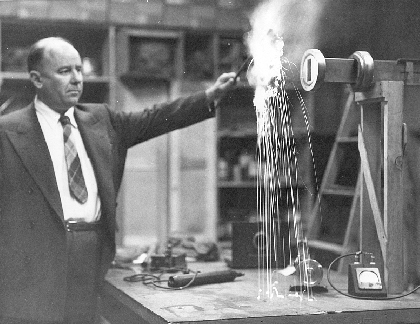
Winfield W. Salisbury showing
microwave output from waveguide. |
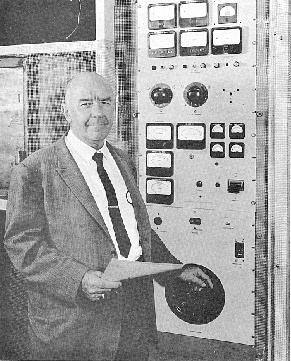
Winfield W. Salisbury At Varo
Garland Texas |
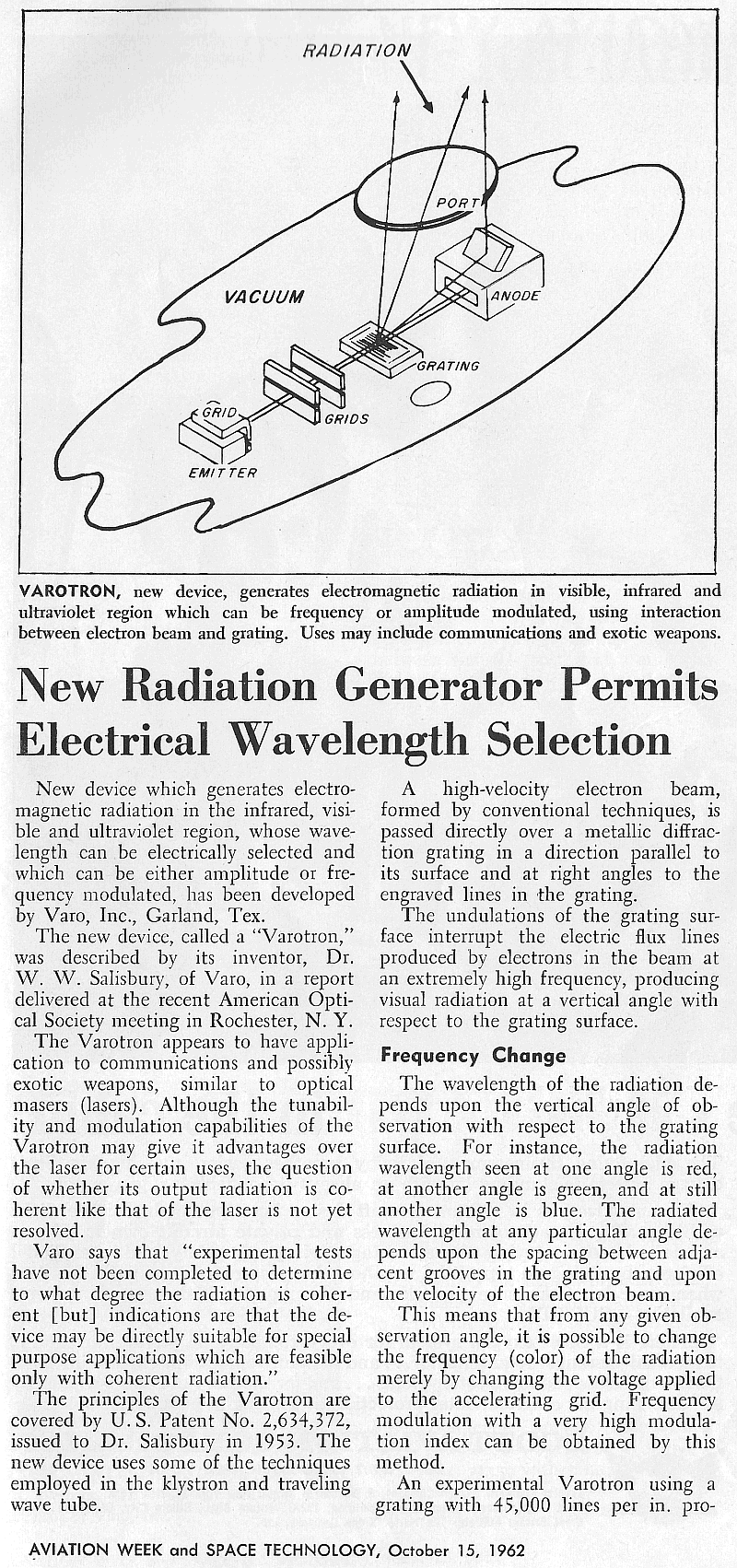 
|
LINE DRAWING OF VAROTRON
INNARDS AND HOW WORKS
VAROTRON, new device, generates electromagnetic radiation in visible, infrared and
ultraviolet region which can be frequency or amplitude modulated, using interaction
between electron beam and grating. Uses may include communications and exotic weapons.
New Radiation Generator Permits
Electrical Wavelength Selection
New device which generates electro
magnetic radiation in the infrared, visi
ble and ultraviolet region, whose wave
length can be electrically selected and
which can be either amplitude or fre
quency modulated, has been developed
by Varo, Inc., Garland, Tex.
The new device, called a "Varotron,"
was described by its inventor, Dr.
W. W. Salisbury, of Varo, in a report
delivered at the recent American Opti
cal Society meeting in Rochester, N. Y.
The Varotron appears to have appli
cation to communications and possibly
exotic weapons, similar to optical
masers (lasers). Although the tunabil
ity and modulation capabilities of the
Varotron may give it advantages over
the laser for certain uses, the question
of whether its output radiation is co
herent like that of the laser is not yet
resolved.
Varo says that "experimental tests
have not been completed to determine
to what degree the radiation is coher
ent [but] indications are that the de
vice may be directly suitable for special
purpose applications which are feasible
only with coherent radiation."
The principles of the Varotron are
covered by U. S. Patent No. 2,634,372,
issued to Dr. Salisbury in 1953. The
new device uses some of the techniques
employed in the klystron and traveling
wave tube.
A high-velocity electron beam,
formed by conventional techniques, is
passed directly over a metallic diffrac
tion grating in a direction parallel to
its surface and at right angles to the
engraved lines in the grating.
The undulations of the grating sur
face interrupt the electric flux lines
produced by electrons in the beam at
an extremely high frequency, producing
visual radiation at a vertical angle with
respect to the grating surface.
Frequency Change
The wavelength of the radiation de
pends upon the vertical angle of ob
servation with respect to the grating
surface. For instance, the radiation
wavelength seen at one angle is red,
at another angle is green, and at still
another angle is blue. The radiated
wavelength at any particular angle de
pends upon the spacing between adja
cent grooves in the grating and upon
the velocity of the electron beam.
|
This means that from any given ob
servation angle, it is possible to change
the frequency (color) of the radiation
merely by changing the voltage applied
to the accelerating grid. Frequency
modulation with a very high modula
tion index can be obtained by this
method.
An experimental Varotron using a
grating with 45,000 lines per in. pro-
duces visual radition in the funda
mental mode at an observation angle
of 20 deg. when electrons have energies
ranging from 65kv. to 155 kv., Dr. .
Salisbury reported.
Observation from a lower angle of 10
deg. permitsusing of a lower energy
electron beam.
The Varotron is based upon an elec
trostatic image theory first proposed by
James C, Maxwell, 19th century Scot
tish physicist. This theory says that a
small spherical charge near a metal
surface will induce a charge of opposite
sign on the surface which behaves in
the manner of a visual image with re
spect to a conventional mirror. The
height of the actual charge above the
surface will determine the apparent
depth of the image charge inside the
metal surface,
In the Varotron, as electrons in the
beam skim along the surface of the
metallic diffraction grating, each elec
tron produces an equivalent charge be
low the grating surface which travels
along parallel with it.
Because of the groove undulations in
the grating, each electron image moves
toward and then away from its electron
in the beam in a periodic manner so
that the two jointly behave like an
oscillating electric dipole. Such an os
cillating dipole is an ideal radiator of
electromagnetic waves at the frequency
at which the dipoles are oscillating, ac
cording to Salisbury,
The radiated frequency as observed in
the laboratory is subject to a Doppler
shift due to the motion of the electron
and its image,
For this reason, the particular fre
quency (color) observed depends upon
the angle of observation as well as the
line spacing of the grating and the ve
locity of the electrons,
Original work on the Varotron was
carried out using company funds, More
recently the Air Force Systems Corn
mand has provided funding.
PHOTO VAROTRON AND W.W.
SALISBURY
EXPERIMENTAL VAROTRON, shown with
its inventor, Dr, W. W. Salisbury, chief
scientist of Varo, Inc.
AVIATION WEEK and SPACE TECHNOLOGY, O(
AVIATION WEEK and SPACE TECHNOLOGY, October 15, 1962 |
|
|
|
|
|
SPECIAL PRESENTATION
SCIENCE & ASTRONAUTICS COMMITTEE
HOUSE OF REPRESENTATIVES
The Hon. Overton Brooks, Chairman
2 FEBRUARY 1960
VARO MFG. CO., INC.
|
|
VARO'S SPACE ROLE
1946 Conceived, developed, and manufactured precision frequency power source which
provided means for the later development of inertia guidance systems.
1952 Conceived the idea of MICROCIRCUITRY which is the reduction of entire electronic circuits to microminiature size. Varo coined the word
MICROCIRCUITRY.
Pictured at left is a radio transmitter produced by MICROCIRCUITRY and the size relative to a penny.
1954 Varo was the first in industry to receive government contract on satellites .... a feasibility study on observation and tracking as a part of Project Orbiter.
Dr. Fred Whipple of Harvard was the principal investigator for Varo.
1954 Varo designed and manufactured the Electrical Power Units used by AVCO and Lockheed on
re-entrance study missiles.
1955 Varo designed and produced the Ground Power System for calibration of the guidance system of the Atlas
Missile.
1956 Varo designed and produced the Electrical Ground Power Supply for
Martin's Titan Missile.
PROJECT STAR STATUS REPORT
JACK G. SMITH
Vice President-Engineering
General Manager R & D Division
Varo Mfg. Co., Inc.
CONCLUSIONS AND SUMMATION BY VICE ADM. DOYLE
QUESTION AND ANSWER SESSION
VARO'S SPACE ROLE
1957 Varo developed the Power Supply for Convair's first successful Atlas
Missile.
1957 Varo designed and manufactured the D-C Power Supply for Martin's Titan Missile.
1958 Varo designed and manufactured the precision timing source used in Van Allen's satellites for radiation
study which produced what is now known as the famous Van Allen Belt.
1958 Designed and produced Varo's Model 6503 and 6505 Frequency Meters which are used for ground checking and firing of Martin's Ti tan
Missile ,
1959 Designed and manufactured Varo's Model 4604 Rotary Bower Supply for use on North American's
X-15.
1959 Designed and produced prototypes of Varo's Model 4310 Static Power Supply for Convair's Atlas Missile.
PROJECT STAR 1959 - PROJECT CARD 1960
|
SPECIAL PRESENTATION
2 FEBRUARY 1960
SCIENCE & ASTRONAUTICS COMMITTEE
HOUSE OF REPRESENTATIVES
The Hon. Overton Brooks, Chairman
VARO MFG. CO., INC. Garland, Texas
PROGRAM CHAIRMAN
VICE ADM. JAMES H. DOYLE, USN (RET)
Vice President
Varo Mfg. Co., Inc.
RADIATION WEAPONS
DR. WINFIELD W. SALISBURY
Technical Director
Microwave Power Laboratory
A Division of Varo Mfg. Co., Inc.
DR. SALISBURY's distinguished career includes the following major achievements.
• Harvard Radio Laboratories - Group Coordinator and Member
of Governing Board for High Power Radar Countermeasures.
• Member of the Ernest Lawrence team at the Radiation Labo
ratory which developed the cyclotron.
• M.I.T. Radiation Laboratories early radar developments.
• Developed the 50,000 watt radar jamming device and super
vised its installation in England to destroy German radar
effectiveness during the invasion.
• Director of Research, Coll ins Radio Company.
Designed and built
Argonne 60 inch Cyclotron
NRL 50 foot Radio Telescope
• Chief Physicist, Lineary Accelerator Division, Atomic
Energy Lab., Cal ifornia Research and Development Company.
60 foot Linear Accelerator, including a 10,000,000
watt Radio Frequency Power System.
• Technical Director, Microwave Power Laboratory, Varo Mfg. Co., Inc.
Project STAR
Proj ect CARD
As a member of the following government scientific boards, he has made significant contributions in the microwave
field.
Project TROY
Project EAST RIVER
Project LAMP LIGHT
NAS-ARDC Woods Hole Study Committee
|
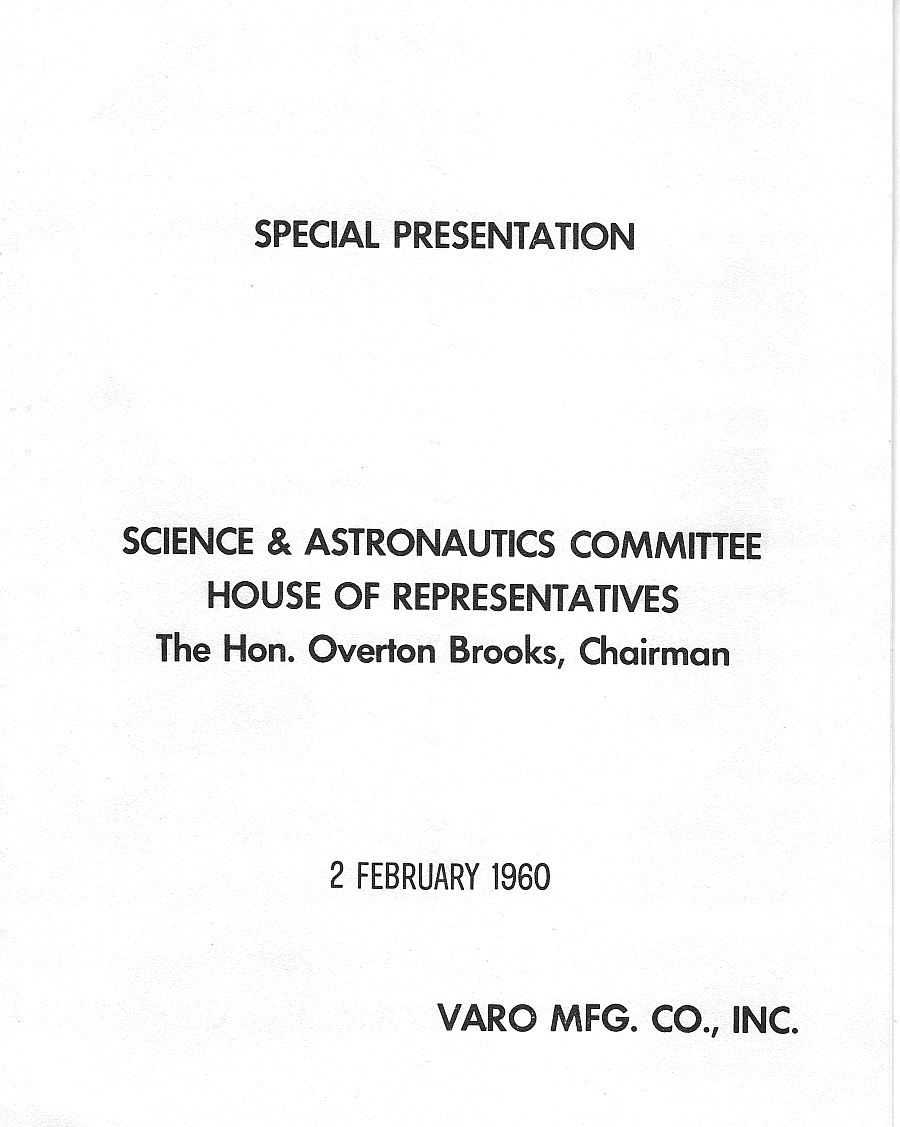
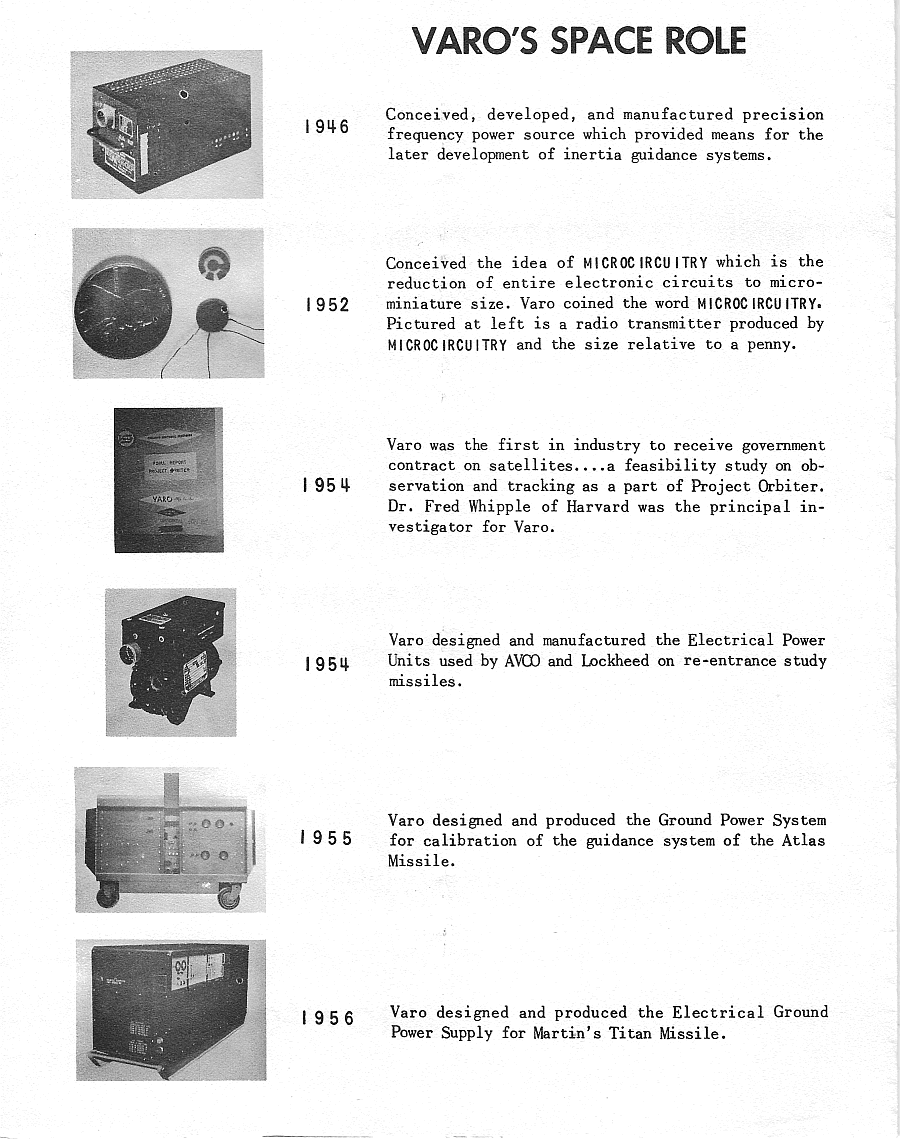
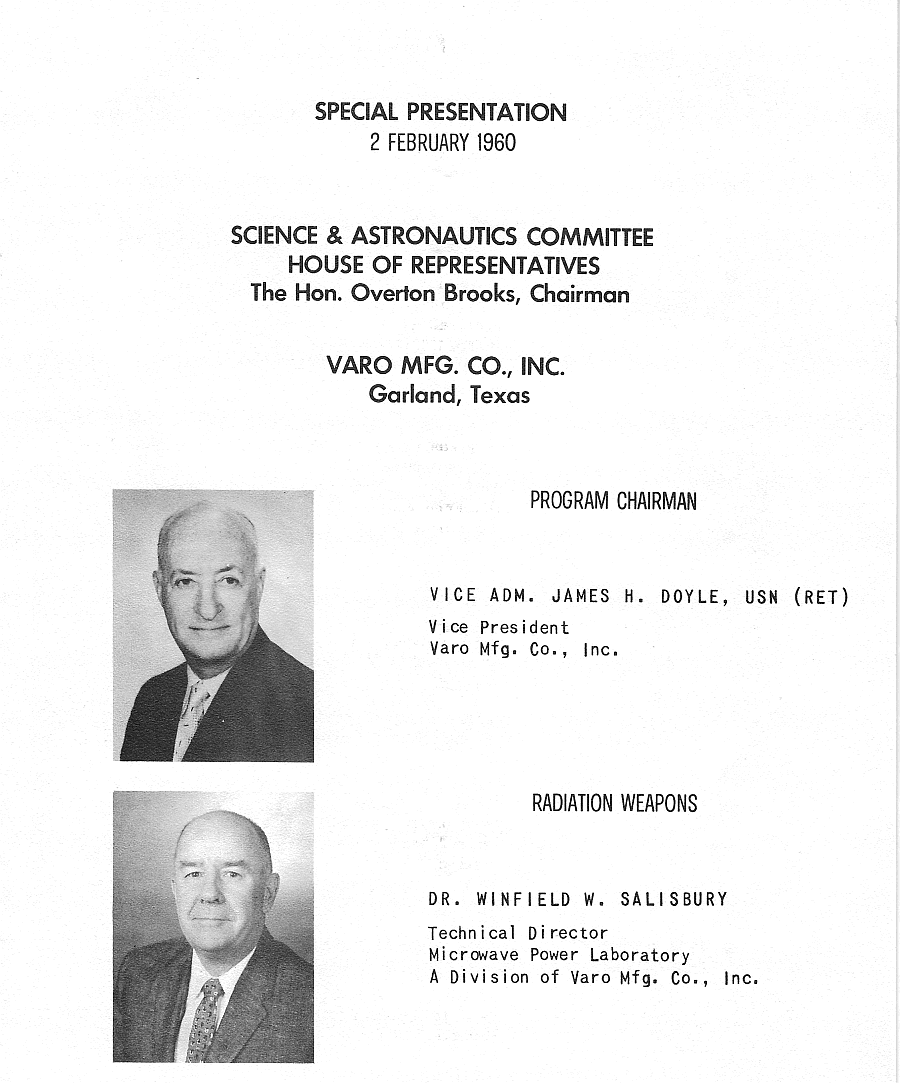
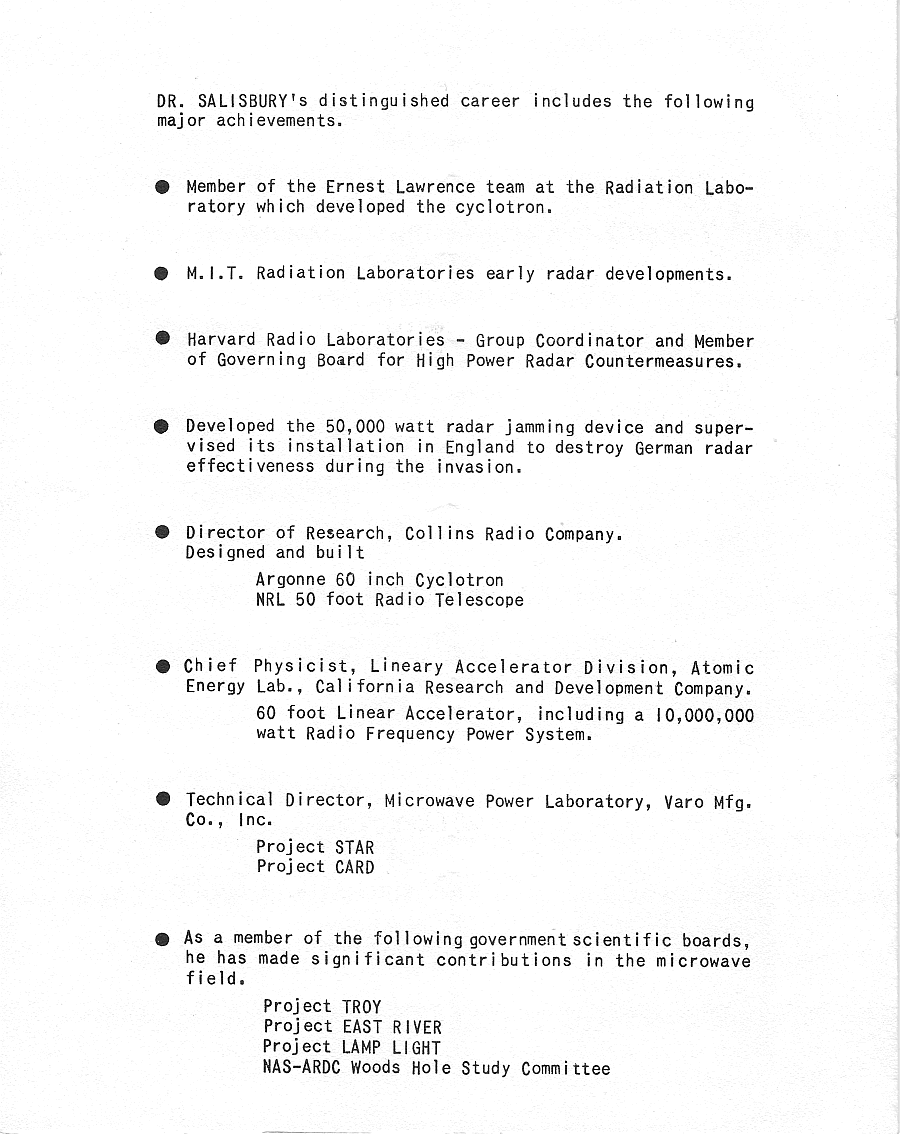
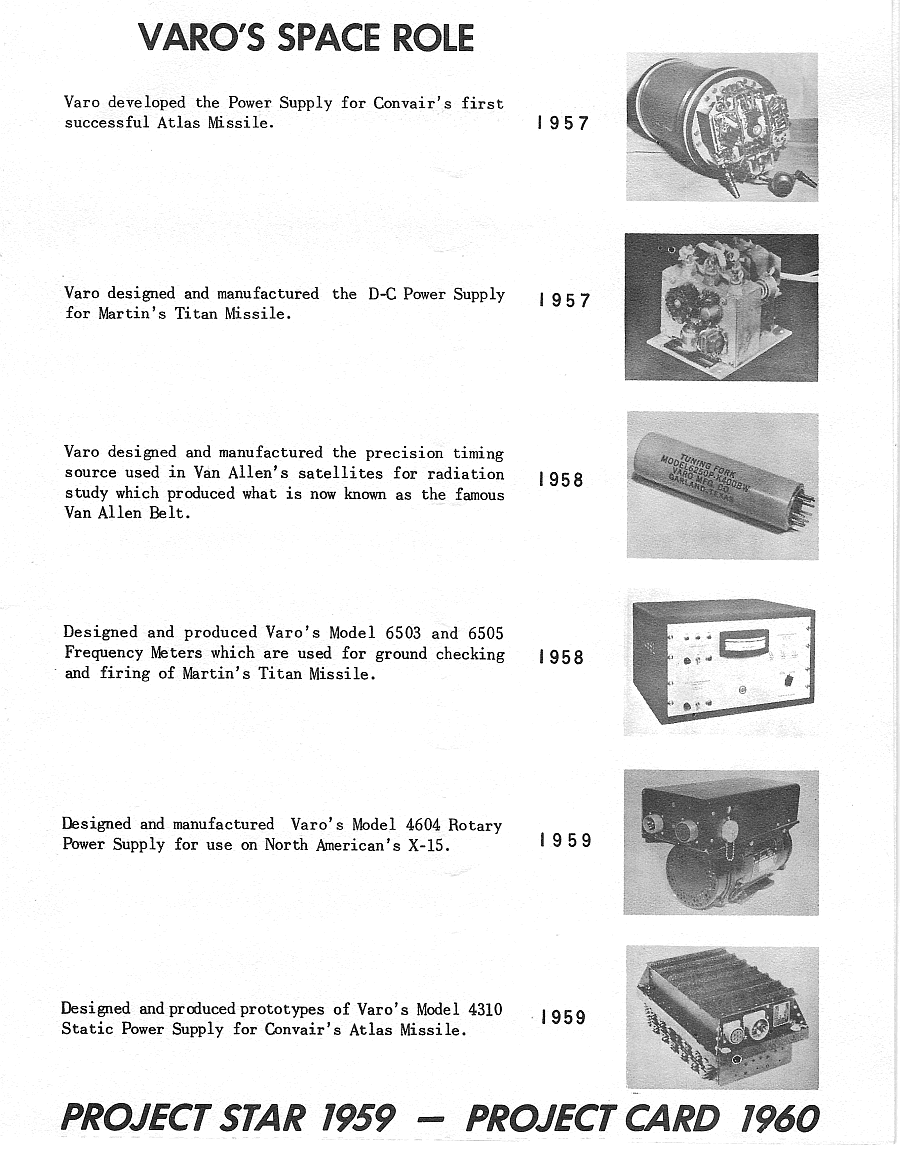
|
|
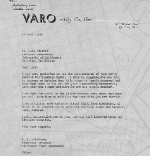 Letter From Salisbury to Luis Alvarez (click
for full screen)
Letter From Salisbury to Luis Alvarez (click
for full screen) |
HISTORY OF PROJECT COMET
1. In June, 1958, Dr. W. W. Salisbury of Varo Inc, presented the
concept of Project Comet to a National Academy of Science Air
Force Summer Study Group at Woods Hole, Massachusetts. The
group reviewed and recommended its implementation by the Air
Force.
2. On the basis of the merits of the program, and at the request
of personnel from Special Weapons Directorate, ARDC Headquarters,
in attendance at Woods Hole, Varo presented a concept and plan to
Lt. Gen. S. H. Anderson, CGARDC, and Major Gen. Leighton Davis,
then Deputy for R&D, in August 1958.
3. Also in August, 1958, Varo made a presentation to ARPAo ARPA
indicated a high degree of interest in the program and encouraged
Varo to present the program formally to the Air Force, stating
that if the Air Force were interested, ARPA would also like to
participate, but that ARPA did not have sufficient funds for a
program of this magnitude by themselves.
4. Varo submitted an unsolicited proposal on September 22, 1958 to
ARDC and ARPA. In addition, Varo presented repeated technical
briefings to ARDC and ARPA personnel and to the technical directors
of the ARDC centers concerned, reviewing and explaining the concept.
In discussions with General Anderson and General Davis, and in
the Varo proposal, a program to conduct theoretical studies and
experiments to prove, or disprove, the feasibility of the Comet
concept was advocated using available hardware to insure minimum
expense and a 'minimum of development. The cost of this program
was $10,094,810.
5. Emergency funds were solicited by the Air Force from DOD during the
Fall of 1958 to carry out the program proposed. The requested funds
were withheld, based on a decision that more theoretical research
was necessary to determine whether or not the proposed $10 million
combined theoretical-experimental program could be justified.
History of Project Comet
Page 2
6. Responsibility for Project Comet was assigned to RADC by ARDC.
Due to the potential magnitude of the program if the ultimate
weapon system was proved feasible, RADC split the Varo proposal
into an experimental program, Project 5562, and a supplementary
theoretical program, Project 5561. In March of 1959, a $9 million
five phase contract was awarded to Varo for the experimental facility
only. Only Phase I ($96,041.05) of the contract was released, due
to lack of FY59 funds. This release of funds was made to avoid
delaying the program. Active FY59 contracts in adjacent fields
were re-oriented to provide theoretical support under 5561.
7. The necessary funds were included in FY60 budget for continuation
of Varo's contract (Project 5562) and the theoretical studies (Project
5561) as recommended by HADC and ARDC, but as a result of a review
by an Air Force SAB group, funding of the experimental facility
(Project 5562) was withheld, pending further theoretical study.
8. In September, 1959, HADC awarded a contract to New York University
to create a special committee to study the concept and to accumulate
and analyze technical output of the theoretical programs in process
for RADC. In addition to the original $96,041.05, Varo's contract
was further amended to add funds of $83,983.87 to cover interim
work, awaiting release of Project 5562. Inasmuch as the decision
was made not to continue Project 5562, no additional funding has
been given to the original contract. It is understood that, in
addition to the contract with New York University, 17 contracts with
other companies were sponsored for theoretical work, and FY60 funds
of approximately $5t million were committed to the program.
9. Upon the suspension of Project 5562 and release of Project 5561,
RADC placed theoretical contracts with 27 different companies. Varo
was solicited for, and was successful bidder on, one contract to
review the work of the other contractors and make recommendations for
History of Project Comet
Page 3
for future experimental requirements. This contract amounted
to $180,024.92. The total amount of approximately $4.2 million
was allocated in FY6l funds to the research program.
10. To date, theoretical studies have disclosed nothing to indicate
that the original Varo concept is technically unsound. On the
contrary, each of the major points within the concept are slowly
proving to be correct. The report of the Scientific Committee,
established by contract with New York University, has concluded
that supplemental facilities will be required before feasibility
of the program can be established. Project Comet personnel at
HADC have proposed that funds be made available for such a supple
mental facility.
11. A new Scientific Advisory Board was appointed, and briefing on
the program was given by RADC in March 1961. This group recommended
negligible changes in the scope of the program. Hence, it is
assumed the funding to be allocated in FY62 is relatively unchanged.
12. Technical analysis of the program has been further complicated
due to the circumstances involved. For example, three different
Scientific Advisory Boards have reviewed the program. The Commander
of ARDC and his Deputy Director for R&D have been changed since
submission of the original proposal, and the office of the Direc
torate for Advanced Weapons at RADC was eliminated in the
reorganization of ARDC. Personnel rotation at RADC, by July of
this year, will be such that none of the personnel to whom the
proposal was originally submitted will be directly involved. |
MEMORANDUM
undated
For the past three years studies on the principles of certain exotic
weapons have been conducted. These weapons are:
A. Radiation weapons of limited range
B. Radiation weapons of long range for use against IC~Is.
The effectiveness of these weapons lies in the fact that they can destroy
their objective by producing extremely high temperatures on or at the target.
Typical characteristics include:
1. They can be focused so that the energy transmitted is concentrated
on the target.
2. Their range could be approximately 2 miles with an antenna measuring
30 feet in diameter.
Such weapons could be mounted on a truck or other land vehicle, or installed
on board ship. In addition, devices are under development which, when
perfected, will reduce the size of the antenna to 30 inches thus permitting
it to be airborne.
Limited range radiation weapons can also be extremely effective against
personnel. Additional capabilities of these are:
As an anti-aircraft weapon
The destruction of mine fields
Illumination of targets by creating a fireball
As an anti-tank weapon
Wireless power transmission.
The feasibility of such weapons can be demonstrated with existing hardware
and at a cost of approximately $300,000 for each of the above classes.
A third class of radiation weapon, that for use against ICBMs, could have
a range as great as 1000 miles. The array transmitting the energy could
act as its own radar and would be self focusing so as to remain on the target
- 2 -
until the target is destroyed. It could handle the problem of decoy
missiles since it would simply destroy those as well as the ICBMs with
warheads. It should be noted tha.t absolute discrimination between decoy
missiles and the true ICBM has not been demonstrated by an anti-missile
missile system such as the Nike Zeus.
Admittedly the cost of such a weapon would be high, but once built the
energy cost per shot would be about $50 and the weapon, unlike the fired
anti-missile missile, would still be available for further use.
Since this weapon differs basically from the intermediate range radiation
weapon only in size and range, it can be used where appropriate for the
purposes listed under the intermediate range weapons. For example, it is
the perfect long range anti-aircraft weapon. The anti-ICBM radiation weapon
is basically defensive and hence could be placed in the territories of our
allies without adverse political implications.
Radiation weapons have this outstanding characteristic: the destructive
energy is transmitted to the target on the line of s ight and with the
speed of light. Since the radiation travels with the speed of light, it
has an overwhelming advantage over the anti-missile missile which has merely
the same speed as the ICBM.
Although contractors have spent over one-half million dollars of their own
money working on the principles of these weapons and have made numerous
presentations to the various services, to date mainly the Air Force has
shown any interest and that interest is solely in the long range anti-ICBM
radiation weapon. The Air Force contracts have been confined to purely
theoretical studies. These studies may take years, whereas it is believed
that feasibility can be established for the anti-ICBM weapon in a comparatively
short time with experimental equipment using existing hardware at a minimum
expense when compared to the anti-missile missile program.
No service has shown sufficient interest in the lesser weapons as described
above, although they are unquestionably scientifically sound and comparatively
inexpensive.
- 3 -
Many civil servants and scientists in the Department of Defense with whom
radiation weapons have been discussed seem to be greatly concerned about
advocating a substantial program to develop these weapons. In the minds
of same, exotic weapons are classified as "science fiction" and the civil
servants and scientists apparently fear that they may damage their scientific
reputations by such advocacy. They are afraid they might be wrong and are
unwilling to take a risk in spite of the almost unlimited potential value
of such weapons for our national defense.
|
|
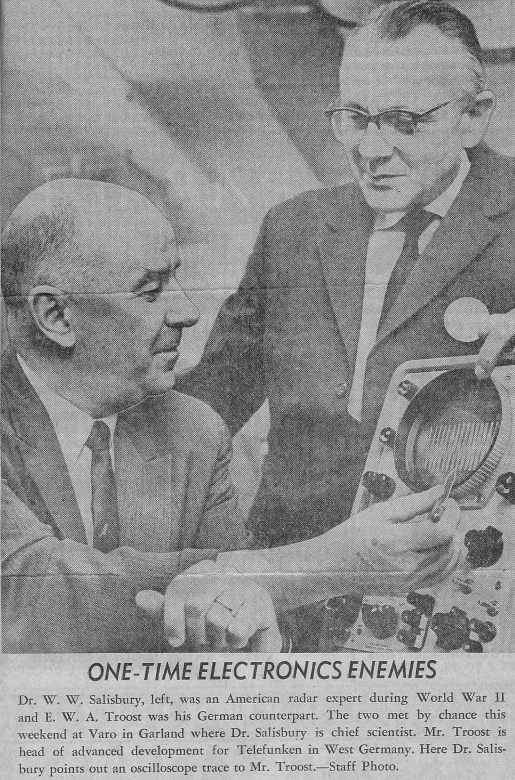
ONE- TIME ELECTRONICS ENEMIES
Dr. W. W. Salisbury, left, was an American radar expert
during World War II and E. W. A. Troost was his German counterpart. The two met
by chance this weekend at Varo in Garland where Dr. Salisbury is chief
scientist. Mr. Troost is head of advanced development for Telefunken in West
Germany. Here Dr. Salisbury points out an oscilloscope trace to Mr. Troost.-Staff
Photo.
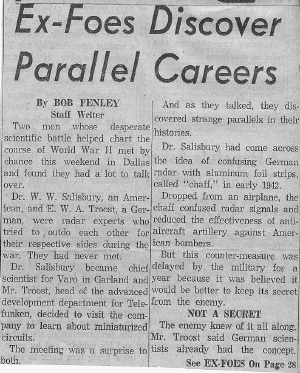
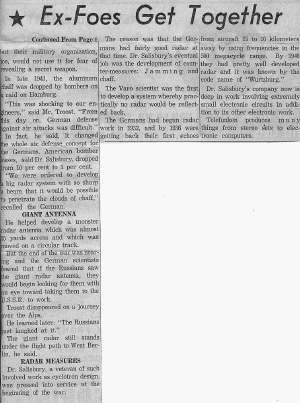
|
|